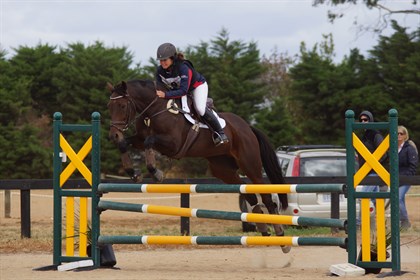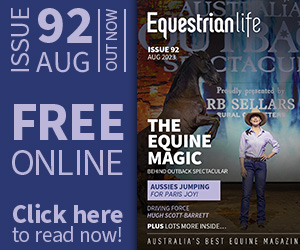|
This article has appeared previously with Equestrian Life. To see what's in the latest digital issue, please click here.

Sophie and Polly at Ballarat Hickstead. Image: Jenelle Christopher.
Scoring the hat-trick
While shopping for your next young horse can be fun, it can feel like a gamble trying to identify the three main traits that eventing will demand from the one horse. It calls for sharp observation and... your own gut feeling.
BY SOPHIE DOAKE (Vet and Eventer)
POTENTIAL EVENTERS ARE arguably the most difficult to pick as young horses, as they essentially have three different jobs to do. Whilst the top event horse must be brave and scopey, it also must have a level head so that at its fittest it is still able to cope with the dressage phase of the competition. In addition to these traits, the horse must be sound and able to withstand the high physical demands that the sport places on them.
First of all, gauge your overall impression of the horse. Having had a background in showing, I tend to go for an elegant, pretty type. Everyone has a type that they like, and in the end you are the one who is going to be riding the horse, so you need to like what is standing in front of you.
CONFORMATION
The way a horse is put together can be highly influential on its ability to successfully perform a specific task.
Front
• Pretty head, kind eyes – I am fussy about their heads, and although it most probably has no bearing on their ability as a performance horse, a nice head with a kind, intelligent eye is a must for me.
• Fine through the gullet – thick-gulleted horses look less elegant, and often find it difficult to flex from the poll.
• Uphill – the neck should come out of the shoulder nicely.
• Good length of rein and nice shape to the neck – the neck should be at least one third of the length of the horse.
• Correct angle of shoulder – not too steep or flat.
Body
• Short back – I don’t like to see a large space between the back of the saddle and the hindquarter.
• Deep-chested – room for a large heart and lungs.
• Not croup high – the withers should be above the point of the hip.
• Large hindquarters – should make up at least 30% of the length of the horse.
Feet and legs
• Long, strong forearms and gaskins, short cannons
• Correct pastern angle – short, upright pasterns increase concussion, whereas a long, sloped pastern (although often making for a comfortable ride) is weak, and will place excessive stress on the tendons and ligaments.
• Straight legs – no significant deviations from the knees or fetlocks.
• Feet – four even, balanced and symmetrical feet.
Movement
Straight, correct and light over the ground. To me, an athletic horse is one that looks light, effortless and ground-covering – not one who hits the ground hard. It must have a good walk, with a large overtrack and a good, balanced canter. The trot is not so important, as it can be significantly improved with work.
Temperament
Arguably one of the most important traits, and often overlooked. A horse can have all the talent in the world, but it still needs to be brave, willing and honest. There is nothing more rewarding than riding a horse that loves its job.
Breeding
I don’t really have a preference for bloodlines. I have always loved Thoroughbreds, and there are certainly lines which are proven in the eventing world, however, I prefer to look at the horse in front of me, rather than how it looks on paper.
Here are three horses that I have purchased off the track. Each has their strengths and weaknesses, as you will see from the photos.

Forrest, 2008 TB gelding by Primus. Finished racing 2012.
Good points: Uphill, “swan neck”, deep through the girth, good angle of shoulder, strong hindquarters.
Faults: Although difficult to see from this picture, Forrest was sickle hocked. This means that although the point of the hock lines up under the rump correctly, the cannon bone angles forward so that the horse is standing under from the hock down. He also had flat, “dinner plate” feet, with very low heels and thin soles. These were managed with side clips, a rolled-toe shoe and sole pads.

Polly, 2006 TB mare by Oamaru Force. Finished racing 2009.
Good points: Short-coupled, strong back-end, nice head with big eyes.
Faults: Croup high.

Jack, 5yo gelding by Break The Vault. Finished racing May 2015. © Trot Shots
Good points: Uphill, leggy and compact but with a good length of rein and a small, pretty head.
Faults: Extremely narrow, very fine-boned.
CONCLUSION
At the end of the day, whether you are planning on going to the Olympics or you just want to enjoy competing at the lower levels, you have to have a good feeling about the horse. This may mean that you need to trust your gut, and surprisingly, this will often pay off.
READ THE LATEST NEWS ARTICLES HERE

|

